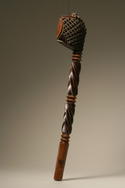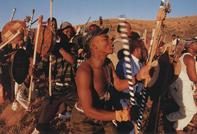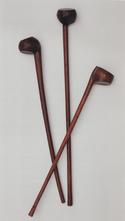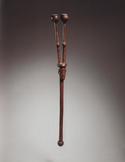
The motifs on this short, but elaborately carved dance staff are unusual partly because the decorative detailing is so robust, but also because of the extent to which the staff has been embellished.
The use of wart-like amasumpa patterns on the head of the staff suggests that the carver was probably from the Zulu kingdom. Highly skilled carvers sometimes worked alongside blacksmiths who were employed to cast brass and copper prestige items reserved for the king and his royal entourage. These prestige items included armbands, many of which were decorated with similarly robust amasumpa patterns.

Today dance staffs are generally embellished with painted decorations or insulation tape rather than elaborately carved motifs. Young men from rural Zulu-speaking communities attending weddings usually carry both short staffs of this kind and fighting sticks which they wave during taxing dance routines characterized by spectacular displays of skills that are applauded by appreciative guests.

According to Zulu oral historian, James Stuart, the top of some staffs are stylized allusions to the shape of the human head. Because fancy staffs like these that vaguely resembled a man's head (izicopo, izishingo) were carried on festive occasions like weddings, they are probably best described as dance staffs.
The scalloped tops of these staffs appear to suggest the shapes of head rings - circular tubes made from a gum-like substance that was sewn into the hair of men who had earned the right to marry.

The unusually complex design of this dance staff suggests that it may have belonged to a king or chief.
Surmounted by two head-like knobs similar to those found on other dance staffs from the Zulu kingdom, the articulated shafts descend onto a head ring worn by a man whose facial features are suggested through the modelling of his nose and ears.
During the 19th century, only seasoned Zulu warriors who had earned the right to marry were allowed to wear head rings.